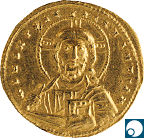

Shortly after being acclaimed by the army as Augustus in A.D. 306, Constantine
the Great (A.D. 306-337) reformed the Roman coinage. He replaced the fundamental
gold denomination of the Roman period, the aureus, with a new and
slightly lighter gold coin, the solidus. Although the introduction
of the solidus did not result immediately in coin designs significantly
different from those of the second and third centuries, over the course
of the following two centuries the solidus gradually evolved into
a coinage with an appearance and identity of its own. By the time of Anastasius
I (A.D. 491-518), the solidus can be clearly distinguished from the
coins of the late Roman empire. On the obverse of the coin, unlike the individualized
profile busts typical of Roman coins, the ruler portrait is presented in
a frontal pose without any attempt at characterization. On the reverse,
pagan subjects popular at the time of Constantine, such as the winged Victory,
are transformed by the incorporation of Christian symbols. The use of the
impersonal frontal ruler portrait and an expanded repertoire of Christian
symbols and subjects feature prominently in the development of Byzantine
coin design.
Despite being replaced by the tetarteron and histamenon in
the tenth century under Nicephorus II Phocas (A.D. 963-969), the solidus
illustrates many of the most significant developments that occurred in coin
design during the Byzantine period. Features such as the stiff, impersonal
ruler-type staring impassively out at the viewer, the employment of either
the civilian chlamys or bejewelled loros for the imperial
costume of the ruler portrait, the adoption of the globus cruciger
and akakia as central elements of imperial insignia, and the use
of the bust-length Pantokrator image of Christ as an obverse type, were
all developed initially on the solidus and retained as central elements
of Byzantine coin design after the demise of the coin type. As a result
the solidus can be considered the most important and characteristic
denomination of the Byzantine period.
THE IMPERIAL PORTRAIT (Continues...)



The coin depicted on this page is No. 146
in the catalogue, histamenon of Nicephorus II Phocas and Basil II, A.D.
963-69. Obverse: facing bust of Christ.
All contents copyright (c) 1996.
Lawrence University
All rights reserved.